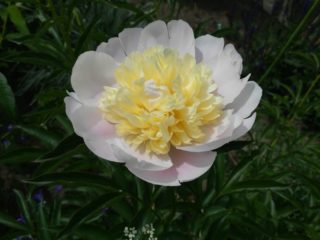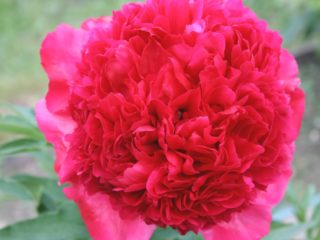Content
Gelikhrizum or immortelle is an unpretentious annual or perennial plant, characterized by a rich range of colors. The culture is used in ornamental gardening and for drawing up dry bouquets. It is better to grow the annual immortelle in a generative way, by planting seeds in open ground or obtaining seedlings beforehand. Perennials propagate generatively or vegetatively.
Growing seedlings
When breeding an immortelle, the seedling method is more often used. It will speed up the vegetation and flowering of the plant. This is especially true in regions with a cold climate. The culture does not respond well to a drop in temperature. Seedlings may die from recurrent spring frosts. The seedling method eliminates this negative factor, because seedlings can be planted in a flower bed when the weather is warm. The immortelle planting material develops well in stationary conditions and quickly takes root in the allotted area.
Timing
The immortelle is determined approximately at the age of about three months on a flower bed. The dates are in early June. According to these parameters, the time of sowing seeds for seedlings is calculated. After laying, the sprouts of the immortelle appear in 20 days. Another 2 weeks pass before the pick.
In the initial period of the growing season, the growth of the plant is slow, the culture gains green mass only at a temperature not lower than +22 0C. If you place immortelle seedlings in a cool room with good lighting, the growing season slows down, the planting material will not stretch out and will not outgrow. The work is carried out in March (in colder climates) and in April (in regions where nighttime spring temperatures rarely drop below zero).
Preparation of containers and soil
For sowing immortelle on seedlings, special plastic containers are suitable, you can use wooden containers. The containers should not be high (15 cm is enough), the width does not matter. To obtain a large number of immortelle seedlings, containers are taken more voluminous. If the container is new, just wash it with warm soapy water and rinse. If the container has already been used, after cleaning it is treated with hot water and a manganese solution.
The soil for planting immortelle seeds is taken dry and well aerated. You can purchase a ready-made mixture or make it yourself from peat, sand and a complex of mineral fertilizers. For satisfactory air circulation, I add small pebbles to the substrate. Before laying in containers, the mixture is calcined, only then fertilizers are introduced into the cold soil.
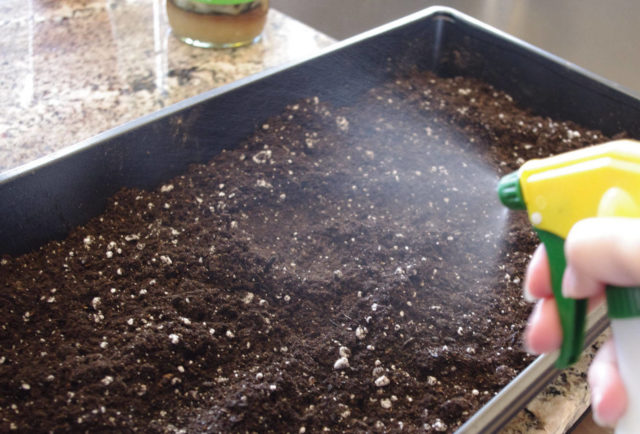
Before planting, the soil is moistened from a sprayer, since the immortelle does not react well to waterlogged soil
Seeding Algorithm
The prepared immortelle material is disinfected with an antifungal agent; for this purpose, a manganese solution can be used.
Sowing sequence of immortelle:
- The prepared mixture is filled to the brim with containers.
- From above, the soil is sprayed with water with the addition of a nitrogen agent.
- Longitudinal lines are made, 0.5-1 cm deep.
- The immortelle is sown arbitrarily, since the seeds of the culture are very small and it is difficult to observe the interval.
- Sprinkle lightly with soil, do not deepen it much.
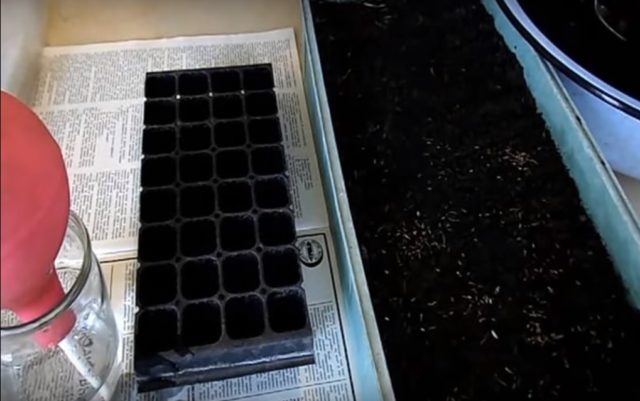
Seeds are scattered over the surface and covered with a substrate.
The containers are not covered from above, since the greenhouse effect is undesirable. Constant soil and air moisture can impair seed germination.
Seedling care
Containers with immortelle are placed in a room with a temperature of at least +20 0C. Periodically moisten the soil with a spray gun to avoid stagnant water. The sprouts will appear in 3 weeks. After that, the containers are rearranged to a sunny place, the daylight hours should be at least 15 hours. If a nitrogen agent was not used during planting, the shoots are fertilized to stimulate growth. After the appearance of three leaves, strong plants are selected from the total mass and dive into separate containers. For this purpose, containers with cells, peat or plastic glasses are suitable.
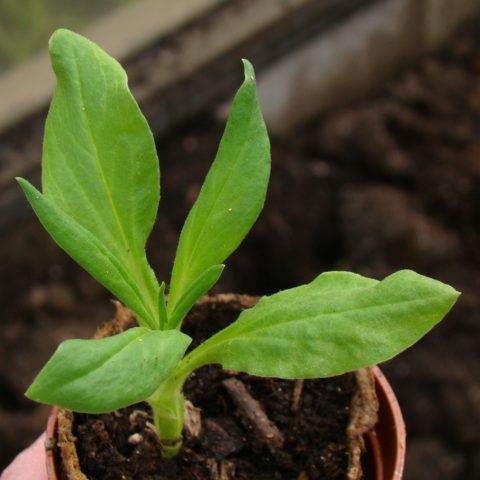
Two weeks before planting on a flower bed, the seedlings begin to harden
To do this, they are taken out into the open air for 30 minutes, gradually increasing the residence time. If there is a greenhouse on the site, it is recommended to leave the plants there before planting.
Planting and caring for immortelles in the open field
The immortelle is a flowering plant that has no special claims to agricultural technology. Subject to biological requirements, the plant will not cause problems when growing.
Timing
It is difficult to determine a clear date for planting the immortelle, they are guided by weather conditions. Planting seeds in open ground in the south can be done at the end of April. In colder climates - in the second half of May.
Seedlings will appear in 2-3 weeks and it is necessary to protect them from a possible drop in temperature. In cold regions, you can sow the immortelle at the same time as in the southern ones, but at night it is necessary to cover the bed with foil. Seedlings are placed on a plot of warm regions at the end of May, in cold climates they are planted in the second half of June.
Site selection and soil preparation
In the wild, the immortelle grows in full sun and dry soil. These conditions are also created for cultivated varieties. The site is determined only open, since in the shade the vegetation is weak and the plant will not bloom. The composition of the soil does not matter, the main condition is a well-drained area. A place with stagnant water is not suitable, on such a site the immortelle will die. Before planting, the soil is dug up, compost or fertilizer for flowering crops is added.

In its natural environment, the plant is common on meadow hills or stony soils
Landing rules
Seeds are sown according to the same principle as for seedlings. Seedlings are placed at intervals of 20 cm. If the soil is in doubt in terms of humidity, and the immortelle variety is perennial, then drainage is placed on the bottom of the hole, small pebbles are suitable for this. The root is covered completely. After planting, the culture is well watered.
Watering and feeding schedule
The immortelle is a drought-resistant plant that can do without watering for a long time, especially during flowering. The plant has enough rainfall. If the season is dry, watering is carried out before flowering so that the soil does not dry out with a small amount of water. The frequency of the procedure is 2 times a week.
Top dressing for annual varieties does not play a special role. If the soil is scarce and outwardly the immortelle looks weak, organic fertilizers are applied (preferably in liquid form).
Weeding
Weeding is included in the conditions of agricultural technology. It is multifunctional, removes weeds from the area and enriches the root system with oxygen. The frequency depends on the intensity of weed growth.
Also, compaction of the upper soil layer should not be allowed, since aeration is vital to the immortelle.
Diseases and pests
The culture is very rare, and even if it is located in the shade or on waterlogged soil. Under unfavorable growth conditions, white rust may develop. If the culture is perennial, it is better to treat it with Bordeaux liquid and transfer it to another place. Annual varieties practically do not get sick.If a problem is found, the immortelle is treated with any antifungal drug.
Of the pests, the culture affects aphids and caterpillars of almost all garden pests. For preventive purposes, the plant is sprayed with Bio Stop in the spring. During budding, "Aktara" is used.
Collection and preparation of seeds
The immortelle retains the decorative effect of the species for a long time. If the flowers dry up and lose their attractiveness, then the peduncles are cut off.
The culture blooms from July to October. The seeds are harvested before the end of the phase, approximately in mid-September:
- Large specimens are cut off.
- Lay out in a sunny place, cover the surface with a cloth.
- Place the baskets with the slices down.

After the flowers have dried, the seeds are removed and stored in a dry place in a paper or canvas bag
Conclusion
You can grow an immortelle generatively or vegetatively. Subject to the conditions of agricultural technology, the cultivation of the plant will not be difficult. The culture does not tolerate waterlogged soil. Vegetation is possible only with a sufficient amount of ultraviolet radiation. The flowering period is long, lasting from July to October.


